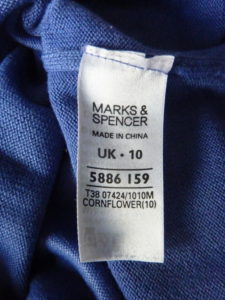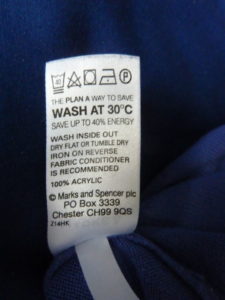
Member of our Planet Sub Group Karen Whitworth has been investigating sustainable fashion – the future of fashion and its environmental impacts. She writes…I am currently undertaking a Future Learn online course entitled “Fashion’s Future and the SDGs” (United Nations’ Sustainable Development Goals) as I am interested to build on my knowledge of the environmental impacts of the various processes involved in clothing production and what the fashion industry is doing to reduce, or eradicate them.
A short assignment was part of my recent learning and I thought other Soroptimists may be interested in what I have found.
How sustainable are our fashion choices?
Our task was to use an item of clothing from our existing wardrobe to answer some key questions about its production and ultimate disposal. Here is my response about the blue jumper I was wearing at the time which was purchased from Marks and Spencer many years ago!
Where did it come from?
 The label shows it was made in China and is 100% acrylic.
The label shows it was made in China and is 100% acrylic.
What are the processes used in its manufacture and what is their environmental impact?
Well…China is the largest producer of acrylics (30% of the world’s use) and it has a petroleum base. It is created in a water based solution with powerful chemical solvents used. Interestingly, colours can be made in the process which eliminates the need for dyes and the harm to the environment from leaching into the rivers and the additional use of water in its production is negated which is obviously positive.
Unfortunately the production processes are highly volatile so there is a risk of explosion and the toxic substances, if not handled carefully can also enter the local ecosystem. The gases produced in this process are so harmful that legislation requires them to be properly filtered in a closed environment.
So through this production process valuable resources are being used and potentially abused through water and air in the locality of its production.
What is the company doing to reduce the impact on the environment and those employed?
Marks and Spencer has signed up to all 10 multi stakeholder initiatives relating to sustainability. For my garment 5 of these initiatives apply as follows:
- improving worker and management co-operation
- working with Greenpeace to achieve zero discharge of hazardous chemicals by 2020 (On the M & S website they have an interactive map which shows they have 55 clothing factories in China, all of which are named).
- working to achieve full transparency of results of environmental and social sustainability through their supply chains
- aiming to reduce carbon, water and waste and
- implementing a code of labour practice which is based on ILO standards.
In their 2020 Plan A report, the CEO of M & S makes a clear commitment that Plan A is being built into their core strategy. They use the UN’s SDGs as a basis and the 21 page document shows the incredible amount of work that is going on behind the scenes within the UK. However, I have not found any evidence that they have met the targets for 2020 within the above 5 initiatives – which is concerning.
How do I look after this garment?
 The label recommends that a 30 degree wash is used. However, my washing machine, bought in 2004, only has a 40 degree wash, so my energy use is increased. But I do not wash my clothes after wearing them only once, so the amount of micro fibres shed will be lower. I also try to reduce the amount of energy used as I do not have a tumble dryer and try to fold clothes carefully and reduce the amount of ironing required as much as possible.
The label recommends that a 30 degree wash is used. However, my washing machine, bought in 2004, only has a 40 degree wash, so my energy use is increased. But I do not wash my clothes after wearing them only once, so the amount of micro fibres shed will be lower. I also try to reduce the amount of energy used as I do not have a tumble dryer and try to fold clothes carefully and reduce the amount of ironing required as much as possible.
What will I do with this garment when I do not want it any more?
Unfortunately this product is not biodegradable and it is practically impossible to recycle. As I keep the majority of my clothes for a very long time it is highly unlikely that it will wear out, but if I do decide I don’t want it any longer I will take it to a charity shop. As there are no signs that it is already quite old it is possible that someone else will make use of it after me!

